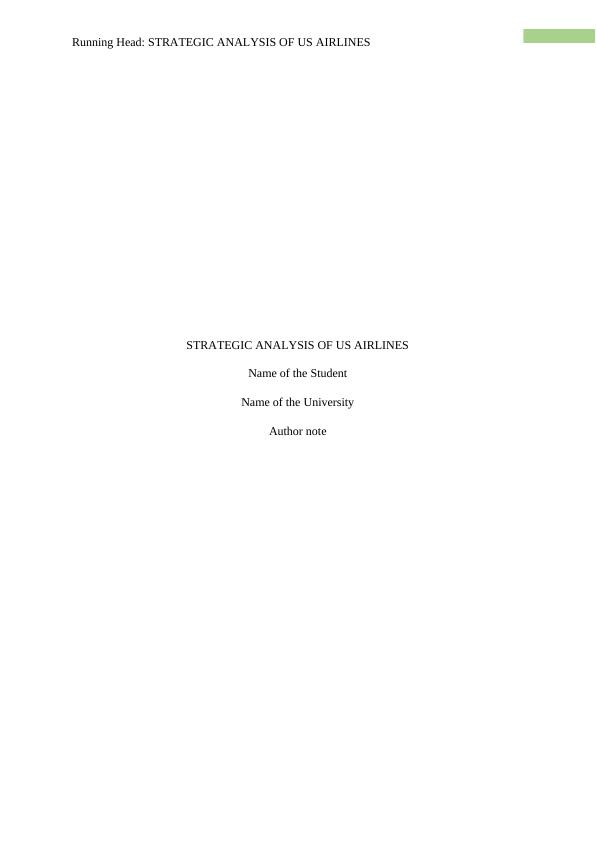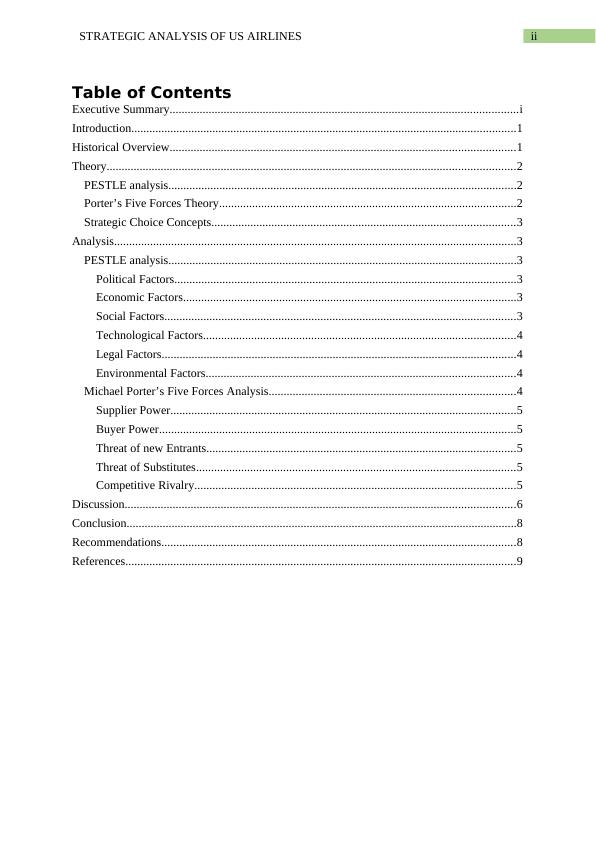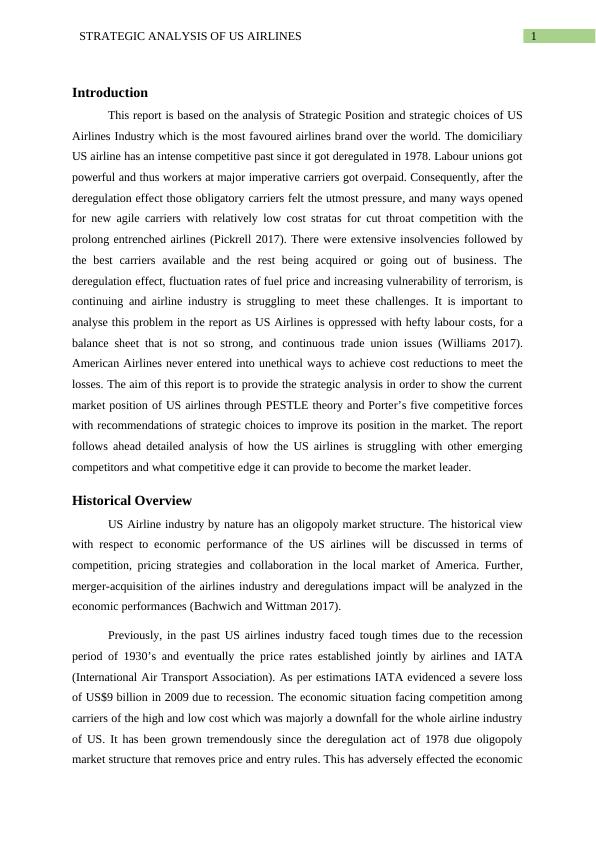Strategic Analysis of US Airlines
Added on 2023-01-17
13 Pages3895 Words94 Views
Running Head: STRATEGIC ANALYSIS OF US AIRLINES
STRATEGIC ANALYSIS OF US AIRLINES
Name of the Student
Name of the University
Author note
STRATEGIC ANALYSIS OF US AIRLINES
Name of the Student
Name of the University
Author note

iSTRATEGIC ANALYSIS OF US AIRLINES
Executive Summary
The report dealt with strategic analysis of US airlines industry. It was designed in a way to
give holistic exposure of the industry, that after deregulation how US airlines would manage
its losses. The study was carried through some analysis such as PESTLE analysis for external
environment and the famous managerial tool Porter’s five forces model to frame strategic
analysis. Basically the aim was to find out the Strategic position and strategic choices for
achieving future goals. Finally, the report carries a clear understanding of the inferences of
strategic concepts followed by the formulated recommendations for company profitability.
Executive Summary
The report dealt with strategic analysis of US airlines industry. It was designed in a way to
give holistic exposure of the industry, that after deregulation how US airlines would manage
its losses. The study was carried through some analysis such as PESTLE analysis for external
environment and the famous managerial tool Porter’s five forces model to frame strategic
analysis. Basically the aim was to find out the Strategic position and strategic choices for
achieving future goals. Finally, the report carries a clear understanding of the inferences of
strategic concepts followed by the formulated recommendations for company profitability.

iiSTRATEGIC ANALYSIS OF US AIRLINES
Table of Contents
Executive Summary....................................................................................................................i
Introduction................................................................................................................................1
Historical Overview...................................................................................................................1
Theory........................................................................................................................................2
PESTLE analysis....................................................................................................................2
Porter’s Five Forces Theory...................................................................................................2
Strategic Choice Concepts.....................................................................................................3
Analysis......................................................................................................................................3
PESTLE analysis....................................................................................................................3
Political Factors..................................................................................................................3
Economic Factors...............................................................................................................3
Social Factors.....................................................................................................................3
Technological Factors........................................................................................................4
Legal Factors......................................................................................................................4
Environmental Factors.......................................................................................................4
Michael Porter’s Five Forces Analysis..................................................................................4
Supplier Power...................................................................................................................5
Buyer Power.......................................................................................................................5
Threat of new Entrants.......................................................................................................5
Threat of Substitutes..........................................................................................................5
Competitive Rivalry...........................................................................................................5
Discussion..................................................................................................................................6
Conclusion..................................................................................................................................8
Recommendations......................................................................................................................8
References..................................................................................................................................9
Table of Contents
Executive Summary....................................................................................................................i
Introduction................................................................................................................................1
Historical Overview...................................................................................................................1
Theory........................................................................................................................................2
PESTLE analysis....................................................................................................................2
Porter’s Five Forces Theory...................................................................................................2
Strategic Choice Concepts.....................................................................................................3
Analysis......................................................................................................................................3
PESTLE analysis....................................................................................................................3
Political Factors..................................................................................................................3
Economic Factors...............................................................................................................3
Social Factors.....................................................................................................................3
Technological Factors........................................................................................................4
Legal Factors......................................................................................................................4
Environmental Factors.......................................................................................................4
Michael Porter’s Five Forces Analysis..................................................................................4
Supplier Power...................................................................................................................5
Buyer Power.......................................................................................................................5
Threat of new Entrants.......................................................................................................5
Threat of Substitutes..........................................................................................................5
Competitive Rivalry...........................................................................................................5
Discussion..................................................................................................................................6
Conclusion..................................................................................................................................8
Recommendations......................................................................................................................8
References..................................................................................................................................9

1STRATEGIC ANALYSIS OF US AIRLINES
Introduction
This report is based on the analysis of Strategic Position and strategic choices of US
Airlines Industry which is the most favoured airlines brand over the world. The domiciliary
US airline has an intense competitive past since it got deregulated in 1978. Labour unions got
powerful and thus workers at major imperative carriers got overpaid. Consequently, after the
deregulation effect those obligatory carriers felt the utmost pressure, and many ways opened
for new agile carriers with relatively low cost stratas for cut throat competition with the
prolong entrenched airlines (Pickrell 2017). There were extensive insolvencies followed by
the best carriers available and the rest being acquired or going out of business. The
deregulation effect, fluctuation rates of fuel price and increasing vulnerability of terrorism, is
continuing and airline industry is struggling to meet these challenges. It is important to
analyse this problem in the report as US Airlines is oppressed with hefty labour costs, for a
balance sheet that is not so strong, and continuous trade union issues (Williams 2017).
American Airlines never entered into unethical ways to achieve cost reductions to meet the
losses. The aim of this report is to provide the strategic analysis in order to show the current
market position of US airlines through PESTLE theory and Porter’s five competitive forces
with recommendations of strategic choices to improve its position in the market. The report
follows ahead detailed analysis of how the US airlines is struggling with other emerging
competitors and what competitive edge it can provide to become the market leader.
Historical Overview
US Airline industry by nature has an oligopoly market structure. The historical view
with respect to economic performance of the US airlines will be discussed in terms of
competition, pricing strategies and collaboration in the local market of America. Further,
merger-acquisition of the airlines industry and deregulations impact will be analyzed in the
economic performances (Bachwich and Wittman 2017).
Previously, in the past US airlines industry faced tough times due to the recession
period of 1930’s and eventually the price rates established jointly by airlines and IATA
(International Air Transport Association). As per estimations IATA evidenced a severe loss
of US$9 billion in 2009 due to recession. The economic situation facing competition among
carriers of the high and low cost which was majorly a downfall for the whole airline industry
of US. It has been grown tremendously since the deregulation act of 1978 due oligopoly
market structure that removes price and entry rules. This has adversely effected the economic
Introduction
This report is based on the analysis of Strategic Position and strategic choices of US
Airlines Industry which is the most favoured airlines brand over the world. The domiciliary
US airline has an intense competitive past since it got deregulated in 1978. Labour unions got
powerful and thus workers at major imperative carriers got overpaid. Consequently, after the
deregulation effect those obligatory carriers felt the utmost pressure, and many ways opened
for new agile carriers with relatively low cost stratas for cut throat competition with the
prolong entrenched airlines (Pickrell 2017). There were extensive insolvencies followed by
the best carriers available and the rest being acquired or going out of business. The
deregulation effect, fluctuation rates of fuel price and increasing vulnerability of terrorism, is
continuing and airline industry is struggling to meet these challenges. It is important to
analyse this problem in the report as US Airlines is oppressed with hefty labour costs, for a
balance sheet that is not so strong, and continuous trade union issues (Williams 2017).
American Airlines never entered into unethical ways to achieve cost reductions to meet the
losses. The aim of this report is to provide the strategic analysis in order to show the current
market position of US airlines through PESTLE theory and Porter’s five competitive forces
with recommendations of strategic choices to improve its position in the market. The report
follows ahead detailed analysis of how the US airlines is struggling with other emerging
competitors and what competitive edge it can provide to become the market leader.
Historical Overview
US Airline industry by nature has an oligopoly market structure. The historical view
with respect to economic performance of the US airlines will be discussed in terms of
competition, pricing strategies and collaboration in the local market of America. Further,
merger-acquisition of the airlines industry and deregulations impact will be analyzed in the
economic performances (Bachwich and Wittman 2017).
Previously, in the past US airlines industry faced tough times due to the recession
period of 1930’s and eventually the price rates established jointly by airlines and IATA
(International Air Transport Association). As per estimations IATA evidenced a severe loss
of US$9 billion in 2009 due to recession. The economic situation facing competition among
carriers of the high and low cost which was majorly a downfall for the whole airline industry
of US. It has been grown tremendously since the deregulation act of 1978 due oligopoly
market structure that removes price and entry rules. This has adversely effected the economic

End of preview
Want to access all the pages? Upload your documents or become a member.
Related Documents
Contemporary Issues in Strategic Managementlg...
|10
|3144
|29
Strategic Analysis of United States Airline Industrylg...
|11
|2965
|29
US Airline Industry: Strategic Choices and Business Strategylg...
|15
|3439
|63
Business Environment of Ryan Airlg...
|22
|4934
|63
Strategy in Travel and Tourismlg...
|12
|3098
|291
Porter’s Five Forces Analysis for Qantas Airwayslg...
|9
|2229
|333
